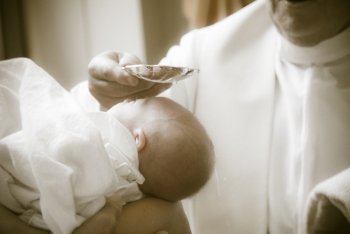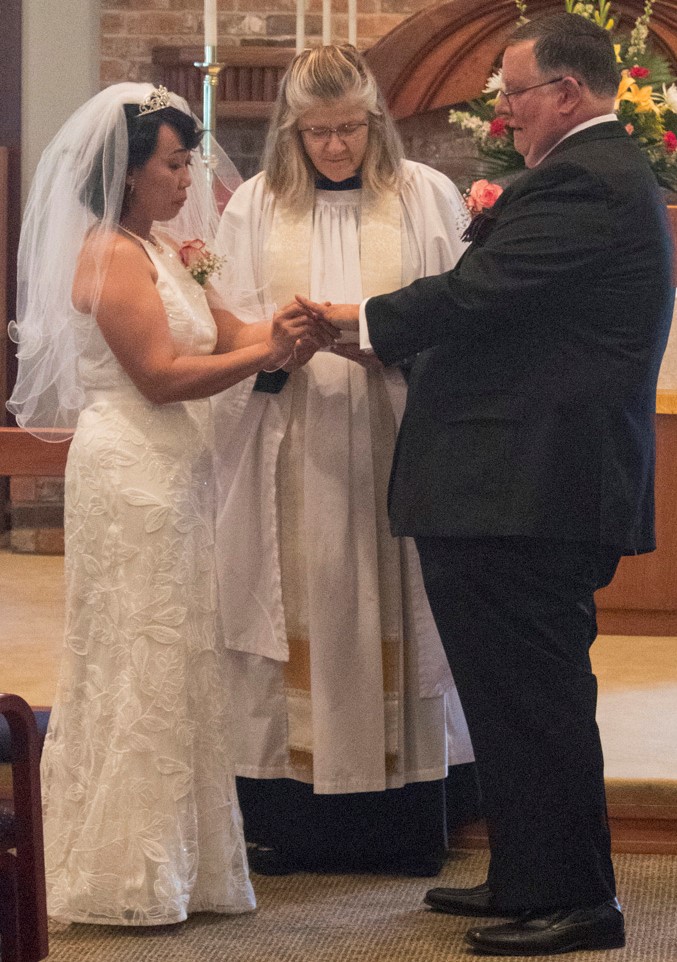
Sacraments & Sacramental Rites
Sacraments in the Episcopal Church are the outward and visible signs of inward and spiritual grace, given by Christ as sure and certain means for receiving God’s grace. Baptism and Eucharist are the two primary and great sacraments given by Christ to his church (Book of Common Prayer, pp. 857-858). The Episcopal Church recognizes that five other sacramental rites came about in the church under the guidance of the Holy Spirit. The five sacramental rites include Confirmation, Ordination, Holy Matrimony, Reconciliation of a Penitent, and Unction (BCP, pp. 860-861).
Holy Baptism
Baptism is full initiation by water and the Holy Spirit into Christ’s Body, the church. God establishes an indissoluble bond with each person in baptism. God adopts us, making us members of the church and inheritors of the Kingdom of God. In the Episcopal Church, any baptized Christian is invited and encouraged to receive Holy Communion.
Holy Eucharist (sometimes called Holy Communion)
The sacrament of Christ’s body and blood, and the principal act of Christian worship. The term from the Greek, “thanksgiving.” Jesus instituted the eucharist “on the night when he was betrayed.” At the Last Supper he shared the bread and cup of wine at a sacred meal with his disciples. He identified the bread with his body and the wine with his blood of the new covenant. Jesus commanded his disciples to “do this” in remembrance of him ( see 1 Corinthians 11:23-26; Mark 14:22-25; Matthew 26:26-29; Luke 22:14-20). Christ’s sacrifice is made present by the eucharist, and in it we are united to his one self-offering (BCP, p. 859). The Last Supper provides the basis for the fourfold eucharistic action of taking, blessing, breaking, and sharing. Christ’s body and blood are really present in the sacrament of the eucharist and received by faith. Christ’s presence is also known in the gathered Eucharistic community.
In the BCP, the whole service is entitled the Holy Eucharist. The first part of the service is designated the Word of God. It usually includes the entrance rite, the lessons and gradual psalm, the gospel, the sermon, the Nicene Creed, the prayers of the people, the confession of sin and absolution, and the peace. The second portion of the service is designated the Holy Communion. It includes the offertory, the consecration of the bread and wine in the Great Thanksgiving, the communion of the people, and the concluding prayers of thanksgiving and dismissal. A blessing may be given prior to the dismissal.
The eucharist is also called the Lord’s Supper, Holy Communion, the Divine Liturgy, the Mass, and the Great Offertory (BCP, p. 859). The Hymnal 1982 includes a section with a variety of hymns for the Holy Eucharist (300-347), including “Come, risen Lord, and deign to be our guest” (305-306), “My God, thy table now is spread” (321), “Now, my tongue, the mystery telling” (329-331), and “I am the bread of life” (335).
Confirmation
The sacramental rite in which the candidates “express a mature commitment to Christ, and receive strength from the Holy Spirit through prayer and the laying on of hands by a bishop” (BCP, p.860). Those who were baptized at an early age and those baptized as adults without laying on of hands by a bishop are expected to make a mature public affirmation of their faith, recommit themselves to the responsibilities of their baptism, and receive laying on of hands by a bishop (BCP, p. 412). Adults baptized with the laying on of hands by a bishop are considered confirmed.
Ordination
The sacramental rite of the church by which God gives authority and the grace of the Holy Spirit through prayer and the laying on of hands by bishops to those being made bishops, priests, and deacons (BCP, p860-861). The three distinct orders of bishops, priests, and deacons have been characteristic of Christ’s holy catholic church. Bishop carry on the apostolic work of leading, supervising, and uniting the church. Presbyters (often known as priests) are associated with bishops in the ministry of church governance , along with the church’s ministry of missionary and pastoral work, in preaching of the Word of God, and in the administration of the sacraments. Deacons assist bishops and priests in all of this work, and have special responsibility to minister in Christ’s name to the poor, the sick, the suffering, and the helpless (BCP, p. 510).
Celebration and Blessing of a Marriage (Holy Matrimony)
Marriage is a solemn public covenant between a man and a woman in the presence of God. At least one of the couple must be a baptized Christian. Prior to the marriage, the couple sign a declaration of intention. It states that they hold marriage to be a lifelong union of husband and wife; that they believe this union in heart, body, and mind is intended by God for their mutual joy, for help and comfort given one another in prosperity and adversity, and for the procreation (when it is God’s will) of children and their Christian nurture.
Reconciliation of a Penitent (Ministry of Reconciliation)
Sacramental rite in which those who repent may confess their sins to God in the presence of a priest and receive the assurance of pardon and the grace of absolution (BCP, p. 861). It is also called penance and confession. The church’s ministry of reconciliation is from God, “who reconciled us to himself through Christ, and has given us the ministry of reconciliation” (2 Cor. 5:18). The ministry of reconciliation has been committed by Christ to the church. It is exercised through the care each Christian has for others, through the common prayer of Christians assembled for public worship, and through the priesthood of the church and its ministers declaring absolution (BCP, p. 446). The Reconciliation of the Penitent is not limited to times of sickness. Confessions may be heard at any time and any place.
Unction
Sacramental use of oil as an outward sign of God’s active presence for healing, initiation, or ordination. Anointing with oil by smearing or pouring may accompany prayers for healing (unction) and the laying on of hands in the rite for Ministration of the Sick (BCP, p.453). The signing with the cross of the newly baptized may be done by anointing with the oil of chrim, which signifies that the person is “sealed by the Holy Spirit in Baptism and marked as Christ’s own forever.” (BCP, p. 308).
|
|
|